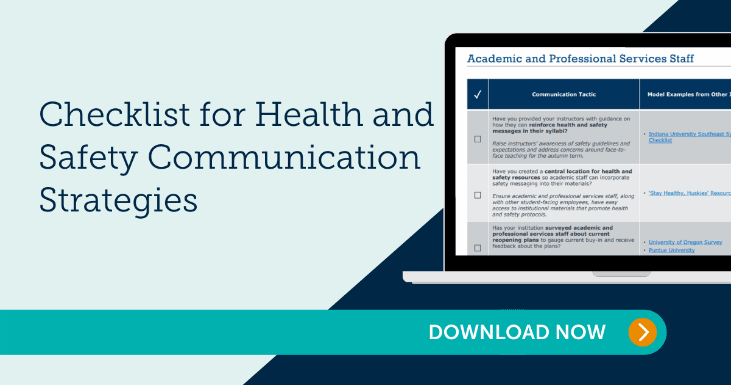As students prepare to migrate back to their campuses, a debate is raging about how – and whether – universities can prevent students from acting like students amidst a pandemic.
A fair amount of scepticism remains. In a survey we ran on this topic in late July, one respondent said, “We’re asking leopards to change their spots.”
This view is borne out in our latest assessment of the sector’s plans to promote health and safety protocols amongst students this autumn. Of 70 US and Canadian and 38 UK universities surveyed, less than a third of North American providers, and not a single UK provider, reported a high degree of confidence that their undergraduate students are able or willing to practice social distancing on campus.
Top concerns centre on motivating students to follow guidelines both on- and off- campus, with 71 per cent of UK respondents especially concerned with students letting their guard down once the term begins.
Our analysis has uncovered three major themes in university plans for promoting physical distancing and safety: expectation setting, positive influence, and enforcement.
We’ve also compiled a checklist for communicating plans and behavioural expectations across campus constituencies, available at the end of this article.
Setting expectations early and often
We know from countless surveys and interviews that most students are eager to come back to campus. Less clear, though, is whether they understand how different their experience will likely be. Setting expectations of “return to learn” must begin long before the start of term.
Yet contrary to past years, when emails sat unopened in inboxes, campus leaders are reporting that their students want to hear from them. In the current climate, early, empathetic, and transparent communication with students is both expected and valued.
Communications teams have shifted towards setting health and safety expectations and guidelines amongst students. Consider these five messaging strategies that institutions are using to set the tone:
Pre-arrival behaviour pledges. At Purdue University, students are expected to review and agree to the Protect Purdue Pledge before arrival on campus. Purdue invoked famous alumni and astronaut Neil Armstrong in marketing their pledge, asking students to “protect the next giant leap.” The campaign emphasises community responsibility, so students understand that their individual actions have campus-wide consequences. It’s no guarantee of student behaviour, but it sets the tone for further messaging. Only a quarter of UK survey respondents report plans to pursue this strategy.
Direct messaging from campus leaders: Almost all surveyed universities report regular sharing of information from senior leaders via email. The most effective of these messages are sent early – well before students arrive on campus. They highlight shared responsibility to keep the community safe, demonstrate the institution’s investment in safety, such as plans for campus sanitisation and mask distribution, and outline changes to safety regulations and the consequences of non-compliance. Virtual town halls have been a popular medium, like the University of Glasgow’s Q&A panel on Facebook Live.
Online training modules: 42 per cent of UK survey respondents report plans to require pre-arrival modules, fewer than in North America. These modules are designed to ensure all students arrive on campus with the same information. The Collaborative Institutional Training Initiative (CITI Program) has created a free module and materials for those not wanting to reinvent the wheel.
Checklists for returning students: Institutions are asking a lot of students this summer. To make sure key requirements don’t get lost, consider creating a centralised checklist where students can easily see everything they must do before returning to campus, like this one from the University of Alabama at Birmingham. An online coronavirus resource centre is the logical place to post resources like this.
Nudges and branding: Not every communication strategy has to consume limited staff hours. 43 per cent of UK survey respondents are distributing coronavirus safety kits to students on arrival on campus, and some are opting to include educational materials on social distancing and even university-branded face masks. No-cost options like email signature bands, like this one at the University of Alabama, can also help to reinforce messages around campus safety.
Leveraging the power of positive influence
Over three-quarters of surveyed UK universities plan to deploy social norming campaigns on social media using student leaders or campus influencers. They are, essentially, relying on the power of positive influence.
As one leader put it, “We want students to return to an already-established student voice. Guidance is not coming from the administration, but from their peers. Students are far more effective in creating parameters around their social experiences than we would ever be.”
Wake Forest University has been an early mover in using peer influence to promote healthy behaviours. Across the summer, Wake Forest identified 17 student influencers who collectively lead or are involved in 38 campus organisations.
The influencers have attended regular training sessions across the summer: they learned about Covid-19’s disproportionate impact on minority populations from the head of diversity and inclusion, discussed best practices for social distancing with a panel of public health experts, and participated in a bystander intervention training. In exchange, the students maintained an active advisory role to senior managers, providing input on all policies, plans, and messaging – and co-authored the student behaviour pledge.
Wake Forest University has equipped its student influencers to take what they have learned and cascade the information to peers. Each influencer is hosting small focus groups with other students to review situations they are likely to face on campus and how to apply the student behaviour pledge. Those students are encouraged to spread the message and have similar conversations with their own friends, organisations, and athletic teams – allowing messages to spread across campus organically.
As with other strategies, leveraging peer influence is no guarantee of compliance. But it can be effective at building social norms. When student leaders reshare university health social media content or are on campus handing out extra masks or safety kits, they send a message about the importance of social distancing and physical safety – and that others should care about it too.
Enforcing student compliance
Asking students to comply with physical distancing guidelines is only part of the challenge. The thornier issue is responding to students who fail or refuse to follow the guidance. While nearly 70 per cent of UK survey respondents are updating student policies and regulations to incorporate physical distancing or quarantine guidelines, only 23 per cent plan to sanction students who violate safety protocols.
Some universities are focusing on low-level sanctions (or none at all) to ensure students are not dis-incentivised from reporting violations or participating in contact tracing. Others are considering referring violators for additional education and coaching, excluding them from academic or non-academic events, and – in extreme cases – even banning them from residence halls or campus.
There’s no clear consensus on the best way to manage non-compliance. Instead, most institutions are pursuing some combination of the following three strategies:
- Establish clear consequences from the start of the term: Update student policies, establish tiered consequences, and host town halls to walk through these changes. Be aware that expectations should not only apply to students, but also to academic and professional services staff, as well as parents, families, and campus visitors. Consistency is key.
- Account for risks in areas where students are least likely to follow distancing guidelines: Most institutions agree that spaces outside the classroom and off campus are the most worrisome—think halls of residence, pubs, or protest events. Consider targeted training for students on interacting in these spaces, or partner with community organisations such as police and off-campus housing authorities that can help monitor and intervene in off-campus activities.
- Simplify reporting for safety violations: 67 per cent of UK survey respondents are planning for some form of community reporting of violations of social distancing and other regulations. In doing so, they must grapple with whether to make this reporting anonymous. Anonymous reporting has the benefit of encouraging participation, but if reports are missing critical information, it will be difficult to conduct contact tracing. There’s also a risk of bad actors reporting false information. Regardless, online reporting forms should be used to standardise and streamline the reporting and investigation process. Claremont McKenna College has adopted its anonymous reporting to address possible violations of its health and safety protocols.
Ultimately, no single strategy can guarantee that students maintain social distancing and follow all health and safety guidelines every minute of every day. However, with a combination of the strategies above, university leaders can communicate to students the importance of modifying their behaviour. Ideally, students will begin to understand the importance of doing so for the good of their peers and others on university campuses and in the community.
This article is published in association with EAB. For more ideas and examples about communicating with various campus populations on this topic, download EAB’s Checklist for Health and Safety Communication Strategies.













